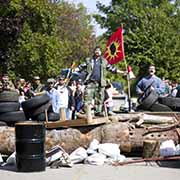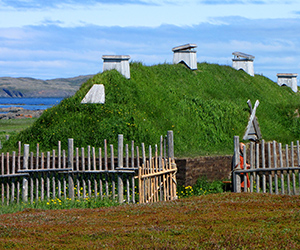CANADA HISTORY
Oka

The Oka Crisis of 1990 stands as one of the most pivotal and emotionally charged events in Canadian history, bringing to the forefront long-standing issues surrounding Indigenous land claims, sovereignty, and government relations. This violent confrontation between the Mohawk people of Kanesatake and the Quebec and federal governments became a national symbol of unresolved Indigenous grievances and the extreme measures some were willing to take to protect their land, culture, and rights. The importance of the Oka Crisis in Canadian history cannot be overstated, as it revealed the deep-rooted conflicts over land use, and the limitations of existing mechanisms for dealing with Indigenous land disputes.
The crisis began as a local land dispute between the town of Oka, Quebec, and the Kanesatake Mohawks but quickly escalated into a national confrontation. The underlying issue was the planned expansion of a private golf course and luxury condominiums onto land that the Mohawks considered sacred, including a burial ground that had been in use for generations. The Mohawks had filed a land claim in 1977 to protect this land, but it was rejected due to the legal technicalities of property titles under Canadian law. This rejection left the Mohawk community feeling betrayed, their historical and spiritual connection to the land overlooked.
In 1989, Oka’s mayor, Jean Ouellette, approved the expansion despite the Mohawks' opposition. For the Mohawk community, this decision represented not just a violation of land but also the disregard of their voice and rights. When initial negotiations failed, members of the Mohawk Warrior Society took direct action in July 1990, erecting barricades around the proposed development site. This was an act of defiance, symbolizing the defense of their ancestral lands and a rejection of Canadian legal authority over what they viewed as Indigenous land.
The crisis quickly escalated when the Sûreté du Québec (SQ), the Quebec provincial police, attempted to dismantle the barricades on July 11, 1990. The violent confrontation that followed resulted in the death of SQ Corporal Marcel Lemay, shot during an exchange of gunfire. This incident inflamed tensions, leading to the blockade of the Mercier Bridge, a critical transportation route between Montreal and its southern suburbs. This blockade severely disrupted daily life in Montreal, alienating many non-Indigenous Quebecers from the Mohawk cause.
The Oka Crisis soon transformed into a nationwide spectacle, with Indigenous communities from across Canada expressing their solidarity with the Mohawks. As tensions mounted, the federal government, led by Prime Minister Brian Mulroney, and the Quebec government under Premier Robert Bourassa, found themselves scrambling for a resolution. The initial response of deploying the RCMP proved insufficient, as they were unable to control the escalating situation. As clashes between Mohawks and the police intensified, Quebec’s government requested military intervention.
On August 20, 1990, Canada’s military, specifically the Royal 22nd Regiment (the Van Doos), was deployed to the site. The sight of soldiers confronting Indigenous warriors at close quarters, heavily broadcast on national news, evoked memories of the October Crisis in 1970, stirring fears of further violence. However, under the leadership of Lieutenant Colonel Robin Gagnon, a negotiated resolution began to take shape, leading to the dismantling of several barricades and the eventual end of the standoff.
Despite the easing of tensions, some militant Mohawk factions refused to withdraw, and it wasn’t until September 25, after weeks of negotiation and further confrontations, that the remaining Mohawk defenders laid down their arms, burning their weapons in a symbolic gesture of resistance. Many of these militants were arrested, marking the end of the 78-day standoff.
The Oka Crisis was a watershed moment in Canadian history for several reasons. First, it exposed the deep-seated tensions between Indigenous land claims and settler interests, which had long been suppressed or ignored by Canadian authorities. While the crisis was resolved without further loss of life, it made clear that the mechanisms for addressing Indigenous grievances were deeply flawed. The legal frameworks in place, as evidenced by the rejected Mohawk land claim, were inadequate in recognizing the historical and spiritual claims Indigenous peoples had to their ancestral lands. Furthermore, the crisis revealed how slow, bureaucratic processes often fueled resentment, leaving Indigenous groups feeling marginalized and unheard.
The crisis also had a profound impact on Indigenous activism in Canada. It became a symbol of Indigenous resistance to colonial structures and sparked greater awareness among Canadians about the history of Indigenous oppression. The use of armed resistance, as controversial as it was, showed the lengths to which some Indigenous communities were willing to go to defend their land and sovereignty. The images of Mohawk warriors confronting Canadian soldiers resonated across the country and internationally, highlighting the fragility of Canada’s relationship with its Indigenous peoples.
Politically, the Oka Crisis served as a wake-up call for both provincial and federal governments. In the years that followed, the Canadian government began a more concerted effort to negotiate land claims and settle outstanding grievances, though progress has often been slow. The crisis also led to the creation of the Royal Commission on Aboriginal Peoples in 1991, which aimed to address the broader issues facing Indigenous communities, including land claims, economic development, and self-governance.
However, the Oka Crisis also hardened attitudes in some quarters. Many non-Indigenous Canadians, particularly those in Quebec, viewed the Mohawk blockade as an unnecessary and disruptive escalation. The blockade of the Mercier Bridge, which inconvenienced tens of thousands of commuters, shifted public opinion, leading to a backlash against Indigenous land claims in some segments of Canadian society. This backlash underscored the polarizing nature of Indigenous issues in Canada and the challenges of reconciling Indigenous rights with the interests of other Canadians.
In summary, the Oka Crisis was not just a localized land dispute but a profound moment in Canadian history, illustrating the unresolved tensions between Indigenous rights and Canadian sovereignty. The crisis forced the country to confront its history of colonialism and the failures of its legal and political systems to adequately address Indigenous claims. It also served as a catalyst for change, sparking national discussions on Indigenous rights, land claims, and the future of Indigenous-settler relations in Canada. Despite these efforts, many of the issues highlighted by the Oka Crisis remain unresolved, with land disputes continuing to flare across the country. The legacy of the Oka Crisis remains a critical chapter in understanding Canada’s ongoing struggle to reconcile with its Indigenous peoples.
Cite Article : www.canadahistory.com/sections/documents




